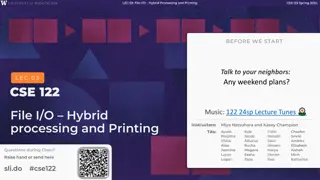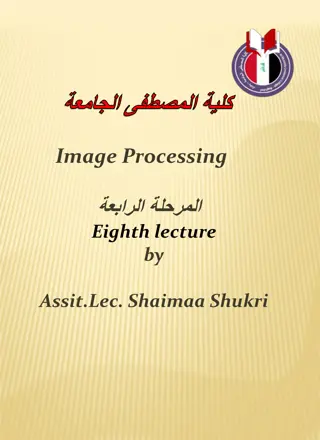
Understanding Fourier Transform and Sampling Theorem in Digital Communications
Explore the concepts of Fourier Transform and Sampling Theorem in digital communications, including their applications in signal processing and information recovery. Learn how signals are transformed from time domain to frequency domain and vice versa, along with the fundamentals of sampling theory. Discover the mathematical principles and practical implications of these essential techniques.
Download Presentation

Please find below an Image/Link to download the presentation.
The content on the website is provided AS IS for your information and personal use only. It may not be sold, licensed, or shared on other websites without obtaining consent from the author. If you encounter any issues during the download, it is possible that the publisher has removed the file from their server.
You are allowed to download the files provided on this website for personal or commercial use, subject to the condition that they are used lawfully. All files are the property of their respective owners.
The content on the website is provided AS IS for your information and personal use only. It may not be sold, licensed, or shared on other websites without obtaining consent from the author.
E N D
Presentation Transcript
. : 2018-2019 Digital Communications CTE Department -3rdstage Reference: Digital Communications Fundamentalsand Applications, 2nd Addition, byFernardSklar Dr. Hussam Dheaa Kamel Al-Mustafa University Collage CTE Department 2018-2019
CTE Department -3rdstage Digital Communications 1.7 Fourier Transform: It is a technique used to transform nonperiodic and periodic signal from time domain to frequency domain and vise versa. Foureir Transform: ?(?) = ?(?)? ????? Or ?(?) = ?(?)? ?2????? ???? ? =2?? Invers Fourier Transform: 1 ?(?)?????? ?(?) = 2? ?(?) = ?(?)??2???? 2
CTE Department -3rdstage Digital Communications Example1 : Obtain the Fourier transform of rectangular pulse of duration T and amplitude A shown below: The rectangular pulse represented by: ? ? ? ? ??? 2< ? <2 ????? ??? ?????= { 0 ? ? ?(?) = ? ???? ( ) FT for?(?) ?(?) = ?(?)? ?2????? ? 2 ? ? [? ?2???]2? = ?? ?2????? = ?2?? 2 ? 2 ? ??[? ???? ????? ? ?2??[? ???? ?????] = = ] 2? 3
CTE Department -3rdstage Digital Communications sin(???) = ??sin(???) ? ?? = ??? ?(?) = ??????(???) 4
CTE Department -3rdstage Digital Communications 5
CTE Department -3rdstage Digital Communications 1.8 Sampling theorem: Sampling of the signals is the fundamental operation in digital communication. Acontinuous time signal is first converted to discrete time signal by sampling process. Also it should be possible to recover or reconstruct the signal completely from its samples. The sampling theorem state that: 1 A band limited signal of finite energy, which has no frequency components higher than W Hz, is completely described by specifying the values of the signal at instant of time separated by 1/2W second and 2 A band limited signal of finite energy, which has no frequency components higher than W Hz, may be completely recovered from the knowledge of its samples taken at the rate of 2W samples per second. Proof of sampling theorem: Let x(t) the continuous time signal shown in figure below, its band width does not contain any frequency components higher than W Hz. A sampling function samples this signal regularly at the rate of fS sample per second. Assume an analog waveform, ?(?) with a Fourier transform, ?(?), which is zero outside the interval ( ??< ? < ??). The sampling of ?(?) can viewed as the product of ?(?) with periodic train of unit impulse function ??(?) defined as 6
CTE Department -3rdstage Digital Communications ??(?) = ?(? ???) ?= The sifting property of unit impulse state that ?(?)?(? ?0) = ?(?0)?(? ?0) Using this property so that: ??(?) = ?(?)??(?) = ?(?)?(? ???) ?= ?(???)?(? ???) = ?= Notice that the Fourier transform of an impulse train is another impulse train. 1 ??(?) =? ?(? ???) ??= 7
CTE Department -3rdstage Digital Communications 8
CTE Department -3rdstage Digital Communications Convolution with an impulse function simply shifts the original function: ?(?) ?(? ???) We can now solve for the transform ??(?) of the sampled waveform: ?(?) ?(? ???) = ?(? ???) So that 1 1 ??(?) = ?(?) ??(?) = ?(?) [? ?(? ???)] = ? ??= ?(? ???) ??= When the sampling rate is chosen ??= 2??each spectral replicate is separated from each of its neighbors by a frequency band exactly equal to ??hertz, and the analog waveform ca theoretically be completely recovered from the samples, by the use of filtering. It should be clear that if ??> 2??, the replications will be move farther apart in frequency making it easier to perform the filteringoperation. When the sampling rate is reduced, such that ??< 2??, the replications will overlap, as shown in figure below, and some information will be lost. This phenomenon is called aliasing. 9
CTE Department -3rdstage Digital Communications Sampled spectrum ??> 2?? Sampled spectrum ??< 2?? A band limited signal having no spectral components above ??hertz can be determined uniquely by values sampled 1 1 at uniform intervals of ? ???. The sampling rate is ? = ? ? 2? ? ? ? So that ?? 2??. The sampling rate ??= 2??is called Nyquist rate. 10
CTE Department -3rdstage Digital Communications Example: Find the Nyquist rate and Nyquist interval for the following signals. ?(?) =sin(500??) i- ? ?(?) = 1 cos(4000??)cos(1000??) ii- 2? Solution: i- 2?? = 500? ? = 250?? ?? = 500?? 1 1 Nyquist interval = = = 2 ????. 2 250 2???? Nyquist rate =2????= 2 250 = 500?? 1 1{ ii- ?(?) = cos 4000?? 1000?? ) + cos(4000??+ 1000??)}] ( [ 2? 2 1 {cos(3000??) +cos(5000??)} = 4? Then the highest frequency is 2500Hz 1 1 Nyquist interval = = = 0.2 ????. 2 2500 2???? Nyquist rate =2????= 2 2500 = 5000?? 11
CTE Department -3rdstage Digital Communications H. W: Find the Nyquist interval and Nyquist rate for the following: 1 i- cos(400??) .cos(200??) 2? 1 ?????? ii- Example: A waveform [20+20sin(500t+30o] is to be sampled periodically and reproduced from these sample values. Find maximum allowable time interval between sample values, how many sample values are needed to be stored in order to reproduce 1 sec of this waveform?. Solution: ?(?) = 20 + 20 sin(500?+ 300) ? = 500 2?? = 500 ? = 79.58?? Minimum sampling rate will be twice of the signal frequency: ??(min) = 2 79.58 = 159.15 ?? 1 1 ??(???)= = 159.15 = 6.283 ????. ??(min) 1 Number of sample in 1??? = 6.283????= 159.16 160 ?????? 12



![Lec [2] Health promotion](/thumb/274962/lec-2-health-promotion-powerpoint-ppt-presentation.jpg)
